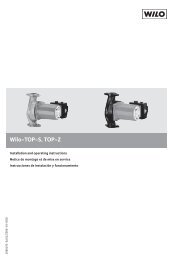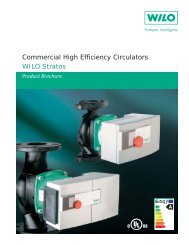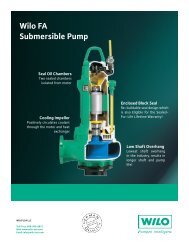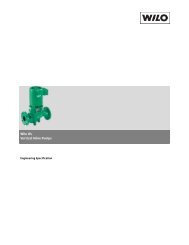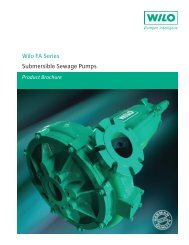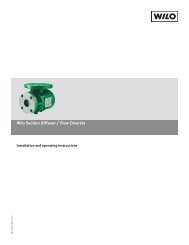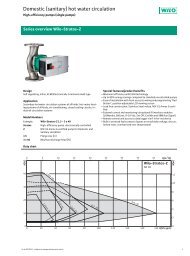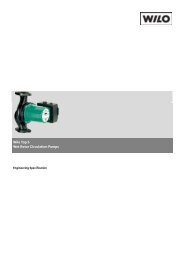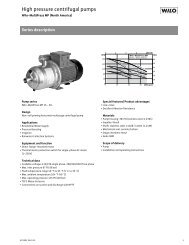Wilo NL Base Mount End Suction Pumps - Wilo Canada Inc.
Wilo NL Base Mount End Suction Pumps - Wilo Canada Inc.
Wilo NL Base Mount End Suction Pumps - Wilo Canada Inc.
You also want an ePaper? Increase the reach of your titles
YUMPU automatically turns print PDFs into web optimized ePapers that Google loves.
practice, the pump bearing housing grease fittings should accessible. Thevent slots on the sides and bottom of the bearing assembly should remainuncovered and completely open. Otherwise, this would tend to “trap” heatinside the housing. This could lead to increased bearing temperatures andpremature bearing failures.18 Mechanical Seals Precautions and RecommendationsMechanical seals are preferred over packing on some applications becauseof better sealing qualities and longer serviceability. Leakage is eliminatedwhen a seal is properly installed, and normal life is much greater than thatof packing on similar applications.<strong>Pumps</strong> containing single mechanical seals normally utilize the pumped liquidto lubricate the seal faces. This method is preferred when the pumped liquidis neither abrasive nor corrosive.19 Operation19.1 Pre-Start ChecksBefore Initial start of the pump, make the following inspectionsIf the pump is installed with a suction lift, priming must be done by othermethods such as foot valves, ejectors, or by manually filling the casing andsuction line.WARNING: Rotating Components HazardImminently Hazardous Situation!Do not operate pump without all guards in place. Failureto follow these instructions could result in serious personalinjury or death and property damage.19.3 Starting• Close drain valves and valve in discharge line.• Open fully all valves in the suction line.• Prime the pump.• NOTE: If the pump does not prime properly, or loses primeduring start-up, it should be shutdown and the conditioncorrected before the procedure is repeated.• When the pump is operating at full speed, open the dischargevalve slowly. This should be done promptly afterstart-up to prevent damage to pump by operating at zeroflow.• Check alignment between pump and motor.• Check all connections to motor and starting device withthe wiring diagram. Check voltage, phase, and frequencyon motor nameplate with line circuit.• Check suction and discharge piping and pressure gaugesfor proper operation.• Turn pump shaft by hand to assure that it rotates freely.• Check driver lubrication.• Assure that pump bearings are properly lubricated.• Assure that coupling is properly lubricated, if required.• Assure that pump is full of liquid (‘PRIMING’) and all valvesare properly set and operational, with the dischargevalve closed, and the suction valve open.• Check rotation. Be sure that the drive operates in thedirection indicated by the arrow on the pump casing asserious damage can result if the pump is operated withincorrect rotation.• Check rotation each time the motor leads have beendisconnected.WARNING: Rotating Components HazardImminently Hazardous Situation!Do not operate pump without all guards in place. Failureto follow these instructions could result in serious personalinjury or death and property damage.19.4 Operating Check• Check the pump and piping to assure that there are noleaks.• Check and record pressure gauge readings for futurereference.• Check and record voltage, amperage per phase, andpower (kW) if a wattmeter is available.• Check bearings for lubrication and temperature. Normaltemperature is 180°F [82°C] maximum.• Make all pump output adjustments with the dischargeline.CAUTION: Cavitation Damage HazardDo not throttle the suction line to adjust the pumpoutput. Failure to follow these instructions could result inproperty damage and/or moderate personal injury.19.5 Freezing Protection<strong>Pumps</strong> that are shut down during freezing conditions should be protectedby one of the following methods.CAUTION: Seal Damage HazardDo not run pump dry, seal damage may occur. Failure tofollow these instructions could result in property damageand/or moderate personal injury.19.2 Priming• Drain the pump; remove all liquids from the casing.• Keep fluid moving in the pump and insulate or heat thepump to prevent freezing.CAUTION: Bearing/Seal Damage HazardDo not let heated pump temperature rise above 150°F[66°C]. Failure to follow these instructions could result inproperty damage and/or moderate personal injury.If the pump is installed with a positive head on the suction, it can be primedby opening the suction and vent valve and allowing the liquid to enter thecasing.8 WIL-IOM-<strong>NL</strong>002-10-11



